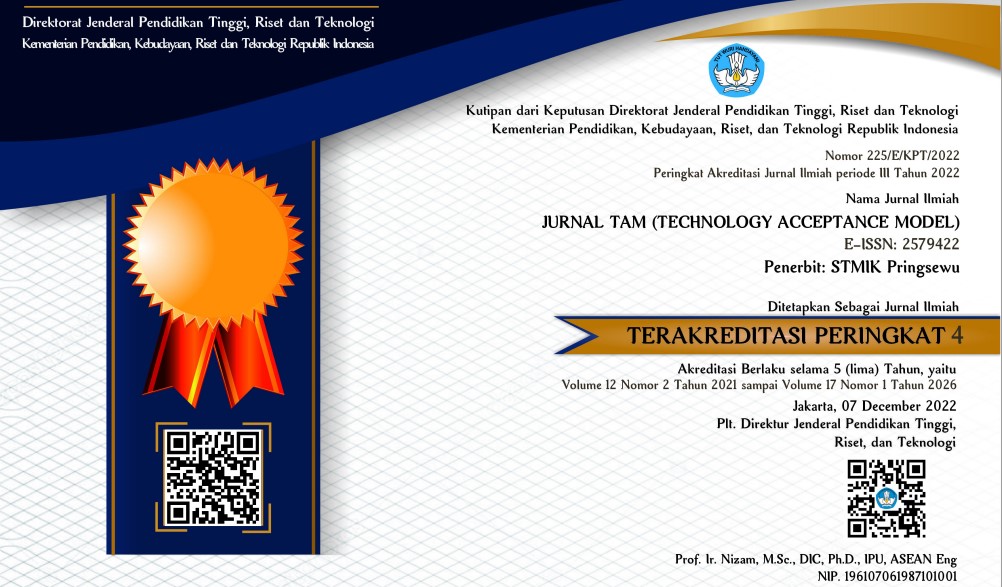APPLICATION OF THE K-MEANS METHOD FOR CLUSTERING BEST SELLING PRODUCTS IN ICE CREAM SALES
(1) Information Systems Study Program, ITBA Dian Cipta Cendikia, Kotabumi, North Lampung, Lampung
(2) Information Systems Study Program, ITBA Dian Cipta Cendikia, Kotabumi, North Lampung, Lampung
(3) Information Systems Study Program, ITBA Dian Cipta Cendikia, Kotabumi, North Lampung, Lampung
 Corresponding Author
Corresponding Author
Abstract
From youngsters to adults, ice cream is a culinary item that is highly sought after by a variety of demographics. The ice cream combination, which includes a variety of culinary items including dairy products, sugars, stabilizers, flavor enhancers, and eggs, is frozen to create this dish. Aice Ice Cream has a wide variety of goods, which makes it popular with customers. According to various data that the author has observed from Agent Aice Harun, including the fact that there are still challenges in the stock of goods available to meet consumer demand, it is necessary to forecast sales of Ice Cream Aice products that are most in demand by consumers in order to facilitate stock provision. Due to these problems, the researchers conducted. The K-Means Clustering Algorithm approach will be applied manually during the clustering process, and Python data mining tools will be used for the implementation. The final calculation results are the same, showing that 48 things are the most desirable, 6 items are pretty attractive, and 6 items are less desirable, according to the results of determining centroid values arbitrarily using the Euclidian Distance formula manually using Python Tools. Agent Aice Harun is able to supply goods that are in line with consumer preferences as a result. Python computations and manual calculations get the same conclusion. Therefore, it is evident from these data that the accuracy value attained is 100%.
Keywords
References
Y. D. Darmi dan A. Setiawan, “Penerapan Metode Clustering K-Means Dalam Pengelompokan Penjualan Produk,” J. Media Infotama, vol. 12, no. 2, hal. 148–157, 2017, doi: 10.37676/jmi.v12i2.418.
Z. Alamtaha, I. Djakaria, dan N. I. Yahya, “Implementasi Algoritma Hierarchical Clustering dan Non-Hierarchical Clustering untuk Pengelompokkan Pengguna Media Sosial,” vol. 4, no. 1, hal. 33–43, 2023, doi: 10.20956/ejsa.vi.24830.
S. Jari, D. Notifikasi, dan E. Berbasis, “Pengamanan lemari penyimpanan menggunakan sidik jari dengan notifikasi email berbasis iot,” vol. 8, hal. 215–225, 2023.
A. F. Sallaby, R. T. Alinse, V. N. Sari, dan T. Ramadani, “Pengelompokan Barang Menggunakan Metode K-Means Clustering Berdasarkan Hasil Penjualan Di Toko Widya Bengkulu,” J. Media Infotama, vol. 18, no. 1, hal. 99–104, 2022, [Daring]. Tersedia pada: https://jurnal.unived.ac.id/index.php/jmi/article/view/2126
Eka Sugiyarti, Kamarul Azmi Jasmi, Bushrah Basiron, dan Miftachul Huda, “Decision Support System of Scholarship Grantee Selection using Data Mining, International Journal of Pure and Applied Mathematics,” Int. J. Pure Appl. Math., vol. 119, no. 15, hal. 2239–2249, 2018, [Daring]. Tersedia pada: https://www.academia.edu/download/57052927/Decision_Support_System_Of_Scholarship_Grantee.pdf
A. I. Waspah et al., “Expectation Maximization Algorithm Memprediksi Penjualan Susu Murni Pada Pt . Sewu Primatama Indonesia Lampung,” JUTIM (Jurnal Tek. Inform. Musirawas), vol. 7, no. 1, hal. 27–38, 2022, [Daring]. Tersedia pada: http://jurnal.univbinainsan.ac.id/index.php/jutim/article/view/1615%0Ahttp://jurnal.univbinainsan.ac.id/index.php/jutim/article/download/1615/822
I. Pendahuluan, “Data Mining Manhattan Distance dan Euclidean Distance pada Algoritma X-Means dalam Klasifikasi Minat dan Bakat Siswa,” vol. 7, no. suryabrata 1995, hal. 835–842, 2023.
M. Annas dan S. N. Wahab, “Data Mining Methods : K-Means Clustering Algorithms,” vol. 3, no. 1, 2023.
E. V. Astuti dan R. Mawarni, “The Comparison Using Expectation- Maximization Algorithm and C4 . 5 Algorithm To Predict the Result of Biogas Production As a Power Plant At Pt Budi Starch & Sweetener ( Bssw ),” hal. 186–198.
A. Nugraha, O. Nurdiawan, dan G. Dwilestari, “Penerapan Data Mining Metode K-Means Clustering Untuk Analisa Penjualan Pada Toko Yana Sport,” JATI (Jurnal Mhs. Tek. Inform., vol. 6, no. 2, hal. 849–855, 2022, doi: 10.36040/jati.v6i2.5755.
A. Y. Simanjuntak, I. S. E. S. Simatupang, dan A. Anita, “Implementasi Data Mining Menggunakan Metode NaãVe Bayes Classifier Untuk Data Kenaikan Pangkat Dinas Ketenagakerjaan Kota Medan,” J. Sci. Soc. Res., vol. 5, no. 1, hal. 85, 2022, doi: 10.54314/jssr.v5i1.804.
F. N. Dhewayani, D. Amelia, D. N. Alifah, B. N. Sari, dan M. Jajuli, “Implementasi K-Means Clustering untuk Pengelompokkan Daerah Rawan Bencana Kebakaran Menggunakan Model CRISP-DM,” J. Teknol. dan Inf., vol. 12, no. 1, hal. 64–77, 2022, doi: 10.34010/jati.v12i1.6674.
S. Mintoro dan A. Afandi, “Implementasi Algoritma K-Means Dan Algoritma Apriori Optimasi Kinerja Ecu (Study Kasus Mobil Avanza Dan Xenia),” J. Inf. dan Komput., vol. 9, no. 2, hal. 81–88, 2021, doi: 10.35959/jik.v9i2.235.
A. Afandi, D. Nurdianah, P. C. Rejo, N. Bayes, dan K. A. Dominan, “Naive Bayes Method and C4 . 5 in Classification of Birth Data,” vol. 16, no. 4, hal. 435–446, 2022.
W. Wahyu Pribadi, A. Yunus, dan A. S. Wiguna, “Perbandingan Metode K-Means Euclidean Distance Dan Manhattan Distance Pada Penentuan Zonasi Covid-19 Di Kabupaten Malang,” JATI (Jurnal Mhs. Tek. Inform., vol. 6, no. 2, hal. 493–500, 2022, doi: 10.36040/jati.v6i2.4808.
Article Metrics
Abstract View : 390 times
: 390 times Download : 239 times
Download : 239 times
DOI: 10.56327/jurnaltam.v14i1.1499
Refbacks
- There are currently no refbacks.






